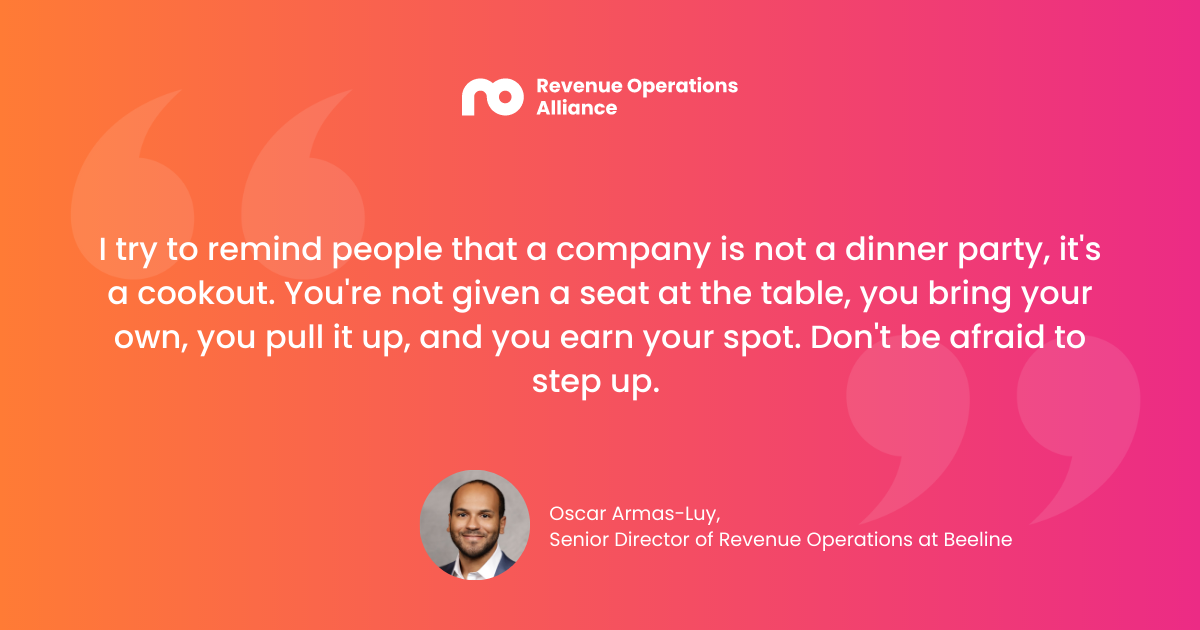Are you looking to unlock the full potential of your organization? Do you want to drive revenue growth, streamline your operations, and empower your sales team?
If so, then embedding RevOps as a strategic function in your organization could be the answer.
RevOps is the glue that holds together your go-to-market strategy, ensuring that your sales, marketing, and customer success teams are aligned and working towards the same goals.
Whether you're a startup looking to establish RevOps from scratch or a larger organization seeking to optimize your existing RevOps function, this discussion will provide you with valuable insights and best practices.
Three RevOps leaders share their insights and experiences on how to build and scale a successful RevOps strategy, covering everything from team structure, to process improvement, roadmaps, and cross-functional collaboration. We were joined by:
- Oscar Armas-Luy, Senior Director of Revenue Operations at Beeline
- Kartikk Mohan, Sales Strategy and Operations Lead at Amazon Web Services
- Jordan Shaheen, Director of Revenue Operations at Candid

We can break up the discussion into these key questions:
- What is revenue operations exactly?
- How has it evolved and what is its future?
- How can you best embed RevOps in your organization?
- How do you structure a successful RevOps team?
- How can you overcome any challenges in building your RevOps strategy?
So sit back, grab a coffee, and let's dive into the world of RevOps.
What is revenue operations exactly?
Revenue operations or RevOps is really just the unification of sales, marketing, and customer success through one team.
Jordan Shaheen defines RevOps as “the amalgamation of marketing, sales, finance, and revenue, into a symbiotic vision for the company”, with one common goal of driving revenue for the business.
Oscar Armas-Luy adds that RevOps, whilst having alignment at its core, is “not just planning, it’s not just execution, it’s where strategic planning meets the execution of discipline to actually get stuff done”.
Kartikk Mohan emphasizes that RevOps “is the glue that holds an organization together”, a strategic function that sits between the go-to-market teams and the rest of the business, with a responsibility to optimize the revenue process from start to finish.

How has it evolved and what is its future?
Revenue operations as a framework and role has grown in importance in recent years as companies have become more data-driven and customer-centric.
According to Jordan Shaheen, RevOps has evolved from a function that was viewed as a “back-office job” to a critical function that is essential for driving growth. He also emphasizes the excitement that the continued visibility of revenue operations brings him.
Oscar Armas-Luy adds that RevOps has also become more data-driven, with a greater focus on customer success teams to really deliver value to customers.
The expansion of revenue operations as a role has also meant that for Oscar, ‘there's always something new to learn, something new to share, something new to consume, and it's changing so fast that it constantly stimulates your mind and keeps you busy’.
Kartikk Mohan stresses just how far revenue operations has grown, as ‘10, 11 years ago, it wasn’t even called sales ops or RevOps’, but now there’s a team of technology companies that are solving issues and combining everything together for you.
This expansion of tech and intelligence into the world of RevOps has improved the role ten-fold, allowing teams to focus on bigger decisions and business growth.

How can you best embed RevOps in your organization?
Now you have the landscape for adopting RevOps, how can you successfully implement it?
One crucial way is by improving alignment between sales, marketing, and customer success teams, building culture of collaboration and transparency for improved efficiency and productivity.
Jordan Shaheen explains that creating structure and visibility is key, ‘reporting out constantly in a structured format’ so teams ‘know what’s going on and what’s not going on, which is equally important’. It’s important to focus on communicating in a structured, reliable format, so you can become a foundation for cross-team collaboration.
Oscar Armas-Luy highlights the division between teams that have existed since start-up and new teams that have come in with the scale up, as a crucial dynamic to consider. This is where a revenue operations leader steps in, acting as a ‘neutral ally to both sides’, and when you become that you help your organization transition into a new, fully collaborative phase.

To ensure success through aligning teams and creating a culture of collaboration, Oscar Armas-Luy stresses that you need to understand the role you’re expected to play and at the right moment.
He says, ‘sometimes you have to be a therapist, sometimes you have to be a traffic cop’ and sometimes you need to be neither, knowing what to play and when improves the efficiency of your RevOps role.
Another key way you can embed RevOps successfully within your organization is by increase visibility into the customer journey and revenue pipeline, prioritizing customer feedback and product development to inform better data-driven decision making.
From his experience, Kartikk Mohan emphasises the importance of data and revenue pipeline in defining an airtight strategy, showing accurately what worked and what didn’t, working backwards from the end-goal to inform any changes that need to be made going forward.

How do you structure a successful RevOps team?
Leading on from this last point, structuring a successful RevOps team is essential for driving revenue growth and boosting performance.
Here our industry leaders provide insight from their own experiences, from transparency and collaboration to personal innovation and growth opportunities.
Within Oscar Armas-Luy’s team, he has established what he calls a ‘Salesforce Centre of Excellence’, with a multi-layered team of sales enablement, salesforce administrators, and sales development representatives, that all roll into RevOps.
Fleshing out enablement and analytics means that everyone, across all teams, is trained and informed on the whole process as his company scales up.
Jordan Shaheen’s team uses the ‘umbrella of go-to-market operations’ that combines revenue operations, sales operations, marketing success, strategy and operations that roll up to several leaders.
He explains that even though there is delineation between these roles, ‘there’s a tonne of overlap’, forming a very collaborative environment.
Also, at the core of his team, he instills the idea that ‘it is not important to get credit’ or ‘for people to think it was your idea’, actively encouraging others to think it was their idea instead. This keeps the company moving in the right direction as when people think ‘it’s their idea, they adopt it more’ and it boosts engagement and innovation.

How can you overcome any challenges in building your RevOps strategy?
One of the main challenges any RevOps leader faces in embedding a revenue operations strategy into an organization is friction.
This resistance to change that comes from legacy sales and marketing teams can block any of the cohesive work RevOps aims to achieve.
All three of our industry leaders agreed that friction is an inevitable part of revenue operations and provided key insights into overcoming this challenge or even repurposing this friction to make it productive.
Kartikk Mohan mentioned that friction often arises when there is no alignment between the sales team and product or service. You need to be able to balance all of the new changes to a product that the sales team pushes for with making sure that you can deliver value, making customers happy.
As Kartikk Mohan advises, building transparency with customers about product roadmaps can help manage expectations and sustain positive growth.

Jordan Shaheen also ephasized the importance of communication. As friction is unavoidable, you need to be able to recognise it as a good thing as it allows passion and open conversations. He adds, ‘the more friction the better … I think friction shows growth’.
On the other hand, Oscar Armas-Luy talked about the danger of making these conversations and disagreements public, as this opens up the risk for egos to be hurt and more challenges to arise. His solution to this friction is to make sure that everyone has a chance to voice their disagreements in private.
In the right setting you need to allow people to be heard to avoid detracting from the main goal or mission. He advises that ‘it’s on us as RevOps leaders to make that friction productive as opposed to counterproductive’.
Final thoughts
RevOps has emerged as a critical strategic function that unifies sales, marketing, and customer success teams to drive revenue growth and streamline operations.
As this article has shown, successful adoption of RevOps requires a culture of collaboration, transparency, and data-driven decision making.
It also demands effective team structuring and the ability to overcome the inevitable friction that arises when embedding RevOps in an organization.
By following the best practices and insights shared by industry leaders in this discussion, organizations can unlock the full potential of RevOps and revolutionize their operations to achieve sustained growth and success.
Fancy contributing your thoughts to an article? Get in touch with us to discuss! 👇








